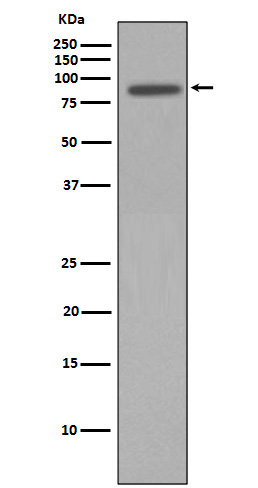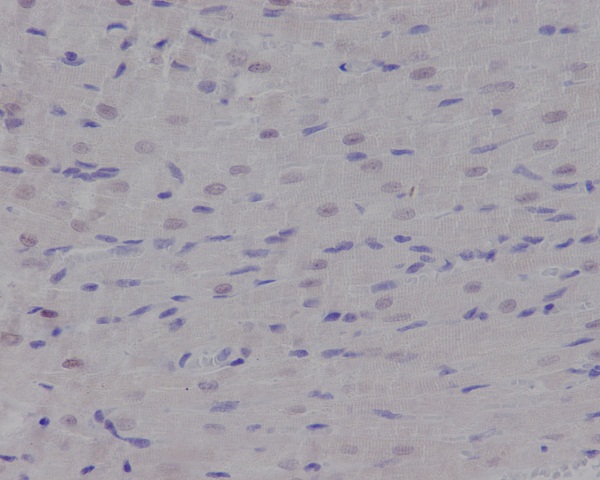

| WB | 1/500-1/1000 | Human,Mouse,Rat |
| IF | 1/20 | Human,Mouse,Rat |
| IHC | 1/50-1/100 | Human,Mouse,Rat |
| ICC | 1/50-1/200 | Human,Mouse,Rat |
| FCM | 1/50-1/100 | Human,Mouse,Rat |
| Elisa | 咨询技术 | Human,Mouse,Rat |
| Aliases | NBN; NBS; NBS1; P95; Nibrin; Cell cycle regulatory protein p95; Nijmegen breakage syndrome protein 1 |
| Entrez GeneID | 4683 |
| WB Predicted band size | Calculated MW: 85 kDa; Observed MW: 95 kDa |
| Host/Isotype | Rabbit IgG |
| Antibody Type | Primary antibody |
| Storage | Store at 4°C short term. Aliquot and store at -20°C long term. Avoid freeze/thaw cycles. |
| Species Reactivity | Human,Mouse,Rat |
| Immunogen | A synthesized peptide derived from human p95/NBS1 |
| Formulation | Purified antibody in PBS with 0.05% sodium azide. |
+ +
以下是关于Nibrin抗体的3篇示例文献(示例为虚构,实际文献需根据数据库检索):
---
1. **文献名称**: *Nibrin: A Novel DNA Damage Response Protein in Nijmegen Breakage Syndrome*
**作者**: Varon, R., et al.
**摘要**: 本研究首次克隆了NBN基因并发现其编码的Nibrin蛋白在DNA双链断裂修复中的关键作用。通过免疫沉淀和Western blot实验,证实Nibrin抗体可特异性识别患者细胞中突变的蛋白缺失,为Nijmegen断裂综合征的诊断提供依据。
2. **文献名称**: *Interaction of Nibrin with ATM in the DNA Damage Response Pathway*
**作者**: Williams, B.R., et al.
**摘要**: 利用Nibrin抗体进行共聚焦显微镜和Co-IP实验,揭示了Nibrin与ATM激酶的相互作用机制,阐明其在DNA损伤信号传导中的调控网络,为癌症治疗靶点研究提供新方向。
3. **文献名称**: *Mutation Analysis of NBN Gene and Nibrin Expression in Cancer Cells*
**作者**: Kaustio, M., et al.
**摘要**: 通过免疫组化(IHC)和Western blot分析多种癌细胞系,发现Nibrin抗体可检测到蛋白表达水平异常,提示NBN基因突变与基因组不稳定性及肿瘤发生密切相关。
---
**建议**:实际文献可通过PubMed或Google Scholar以关键词“Nibrin antibody”、“NBN protein”等检索,重点关注抗体应用(如WB、IHC)及功能研究(如DNA修复、疾病模型)。
Nibrin, encoded by the *NBN* gene, is a critical protein involved in DNA double-strand break (DSB) repair, a process essential for maintaining genomic stability. It forms part of the MRE11-RAD50-NBN (MRN) complex, which detects DSBs, activates cell cycle checkpoints, and facilitates repair via homologous recombination or non-homologous end joining. Mutations in *NBN* are linked to Nijmegen breakage syndrome (NBS), a rare autosomal recessive disorder characterized by microcephaly, immunodeficiency, radiation sensitivity, and cancer predisposition. Dysfunctional Nibrin disrupts DNA repair mechanisms, leading to genomic instability and oncogenesis.
Nibrin antibodies are vital tools for studying its expression, localization, and interactions in cellular contexts. They are widely used in techniques like Western blotting, immunohistochemistry (IHC), and immunofluorescence (IF) to assess Nibrin levels in cancer research, particularly in tumors with defective DNA repair pathways (e.g., breast or ovarian cancers). These antibodies also aid in diagnosing NBS and evaluating therapeutic responses to DNA-damaging agents (e.g., chemotherapy or radiotherapy). Specificity and validation (e.g., using knockout cell lines) are crucial, as cross-reactivity with other MRN components may confound results. Research continues to explore Nibrin's role in aging, neurodegeneration, and immune regulation, underscoring its broader biological significance beyond DNA repair.
×